The Permian Period gets neglected by toy companies, despite its huge assortment of outrageously strange animals. Maybe this is just because there aren’t any true dinosaurs. When we do get a Permian animal, it’s usually Dimetrodon, where we’re really spoiled for choice. Today we’ll look at Estemmenosuchus, a distant relation of Dimetrodon with anatomy that was just as strange.

This is the third toy version of Estemmenosuchus, and let me open by saying it is the very best. However, the bar is somewhat low, with a stylized skeleton version by Kabaya and an action figure from the Jurassic Park line. There is also at least one high-end resin model, but we are not the high-end resin model blog, are we?
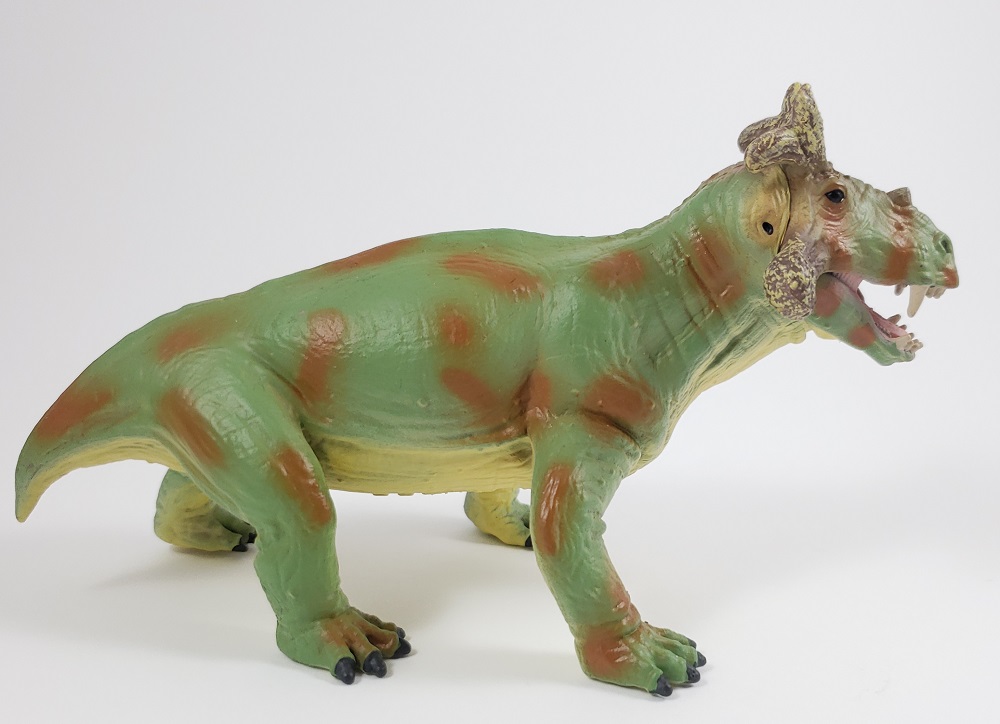
Estemmenosuchus was a large animal for its time, roughly 3 meters in total length. The figure is about 21 cm long, making it about 1:14 scale. This should work well with some Dimetrodon figures, although the two animals almost certainly did not overlap in time. It’s just that there are so few Permian figures, what else are you going to display it with? The figure has much better proportions than the old Jurassic Park version, with a stocky body, robust legs, a short tail, and a long, heavily ornamented head.
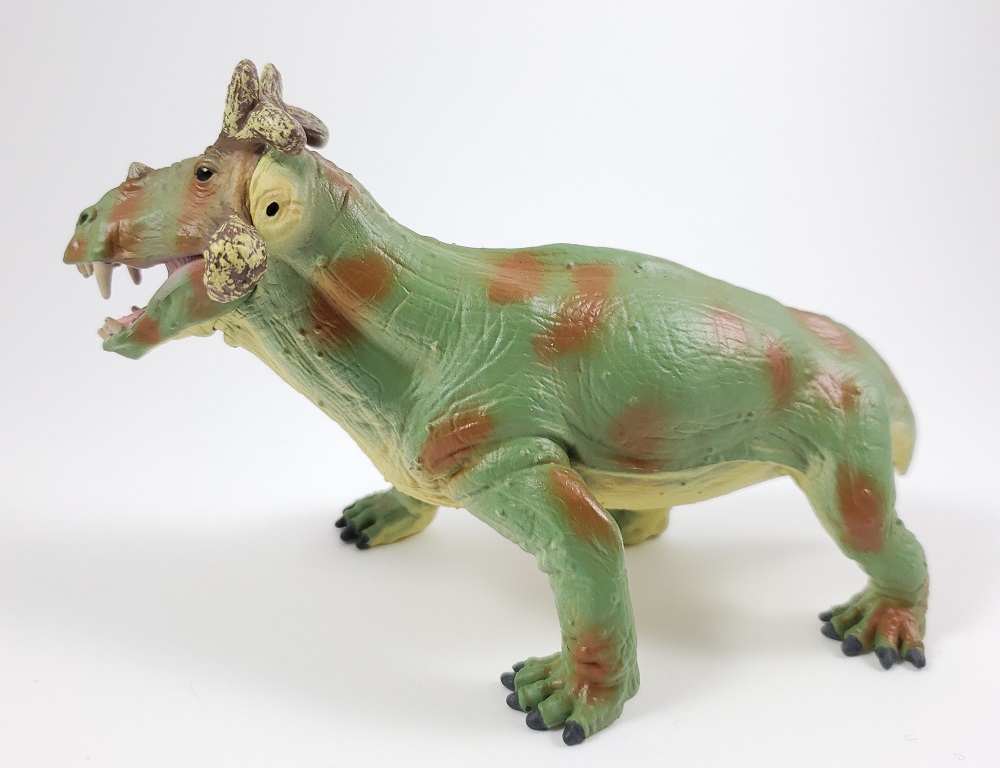
And what a head! The arrangement of head ornaments makes clear that this is Estemmenosuchus mirabilis, rather than the less ostentatious E. uralensis. The sculpt faithfully renders the antlerlike protrusions of the frontal bones (over the eyebrows), the jugals (cheekbones), and the nasal (I bet you can guess this one). They are rendered rather like antlers in that they almost seem to show bare bone showing through. These structures on Estemmenosuchus were emphatically not true antlers, as they show no signs of ever being shed, so it seems unlikely they would have looked much like antlers. That said, it’s really difficult to be sure what would have overlain them. It may have been keratin, in which case the size and shape of the horns in life would have been incompletely dictated by the shape of the bones. There may have been thickened skin and even muscle. The likeliest function of the horns was sex-related combat, so either keratin or thickened skin would have been an advantage to avoid injury. Therocephalians like Estemmenosuchus are all extinct, and although they are more closely related to mammals than to other living animals, all horned (and antlered) mammals evolved their weapons and ornaments separately. That means it’s hard to disprove that the horns were this bony, but I would say it is not very likely.
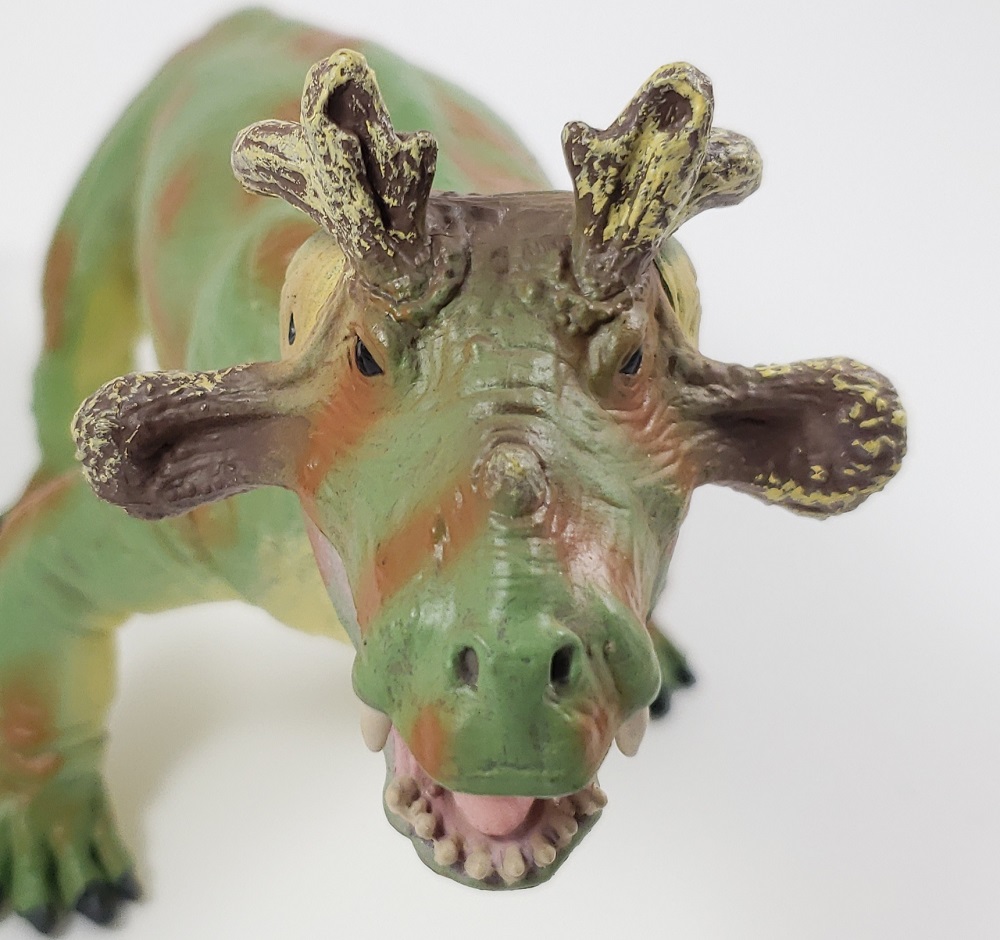
For all that, the head sculpt is really beautiful. There’s a seam where the separately molded head connects to the neck, but it’s artfully placed, partially obscured by the horns. There is an external ear opening, and the eyes and nostrils are in roughly the correct positions. I’m not wild about articulated jaws, but the jaw joint is reasonably well-executed here. The teeth aren’t as egregiously incorrect as on the Jurassic Park version, although the upper jaw features one extra pair of incisors and too few post-canine teeth. This might be at least in part because they would have abutted the joint required to make the jaw mobile. The big caniniform teeth, maybe also used in combat, or to dredge aquatic plants, are nicely sculpted, contributing to a very good overall impression of Estemmenosuchus.

The skin texture of the figure is mostly smooth with wrinkles and tubercles all over. The skin of Estemmenosuchus was probably scale-less, although the paper describing a small patch of preserved integument is more than 50 years old and I am not aware of any subsequent reexamination of the material. In any event, the texture of this figure seems at least plausible. The paint job on top of it is pretty unimpressive, however. It’s mostly a dull olive green, with rusty brown splotches all over the back and sides. Bafflingly, the splotches are symmetric on the head but asymmetric everywhere else. The belly is yellow, and eyes, teeth, inner mouth, horns, claws, and cloaca are all picked out in contrasting colors. Estemmenosuchus was far enough down the synapsid stem that it could still have had three-color vision, so green isn’t by any means out of the question. Still, random blotchiness just isn’t very common in nature, which makes this paint scheme look quite artificial (yes, I know asymmetry does happen, so no need to send me photos of African wild dogs and calico cats). This figure also shows the limitations of airbrushing, which no doubt makes these quick to produce and keeps the costs down, but does a disservice to the detail of the underlying sculpt. A wash or a dry-brush would improve it greatly, as would a color scheme that reflected real thought about ecology and development.
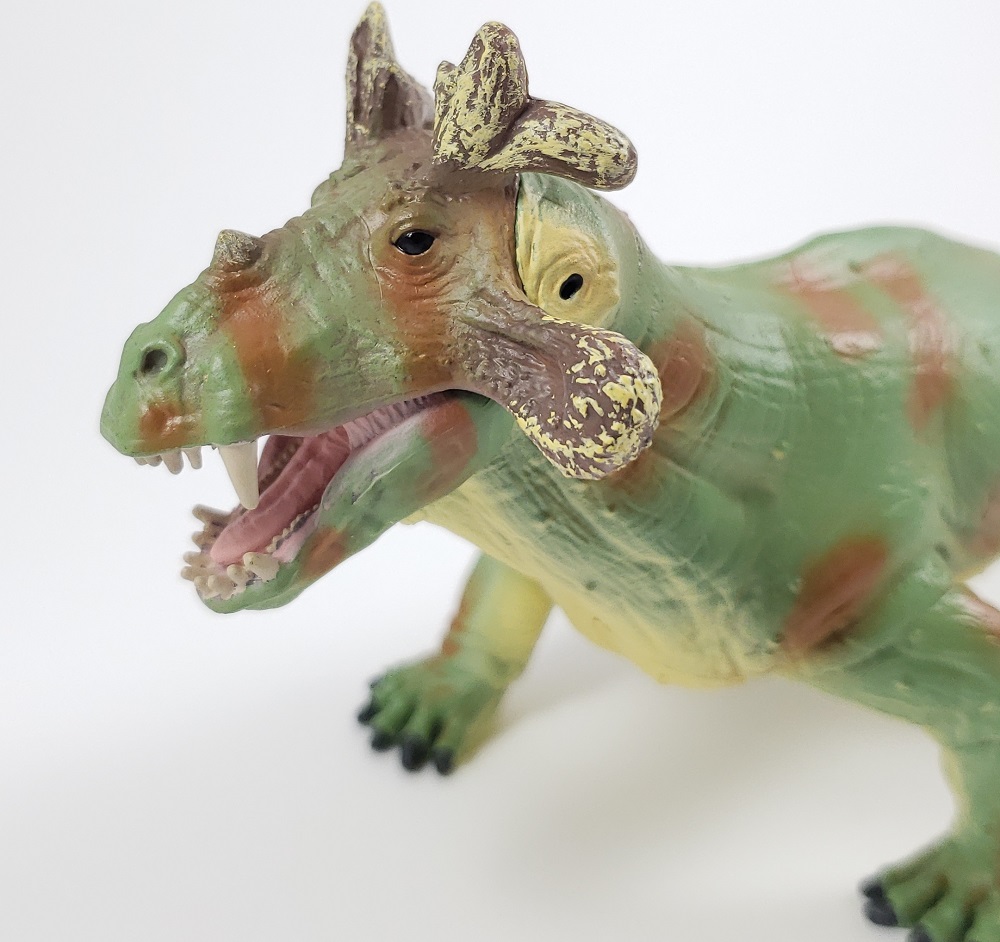
Despite my critiques, I am very glad that CollectA made this figure. High quality Permian figures are thin on the ground, and this is definitely a high quality figure. Coincidentally, it is roughly to the same scale as Schleich’s recent Dinogorgon and displays well next to it, although the two animals were separated by millions of years.
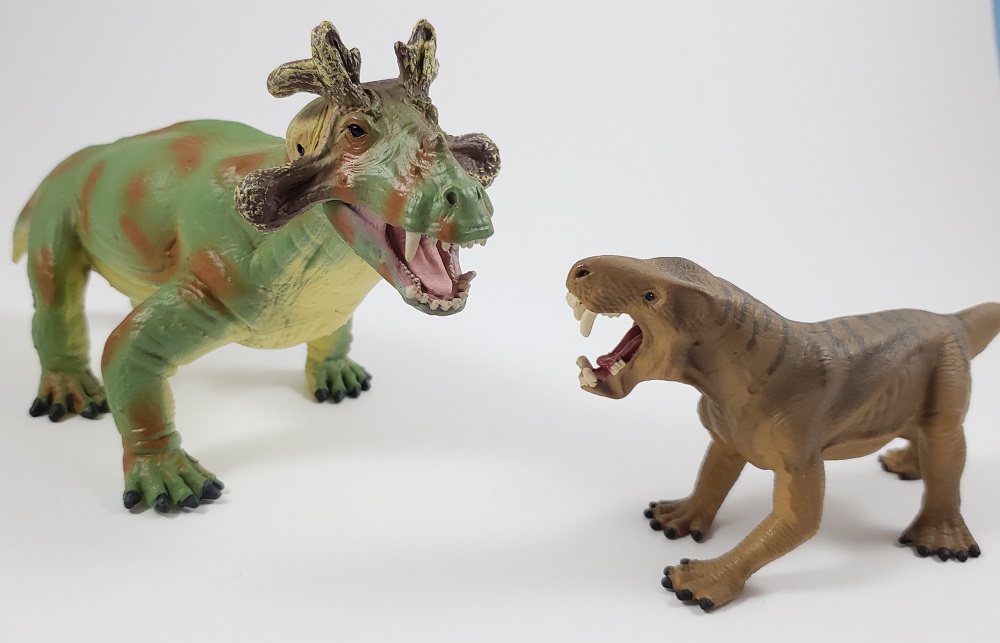
I recommend this figure to everyone, except people who hate fun and interesting things. In fact, I beg you to buy it, so we can get more like it. It’s one of very few Paleozoic animals made by CollectA, and I hope they make many more. Usually, the more often they attempt a particular category of prehistoric animals, the better they get at it (witness their ornithopods, which were pitch-perfect this year). You can get this at good toy sellers all over.
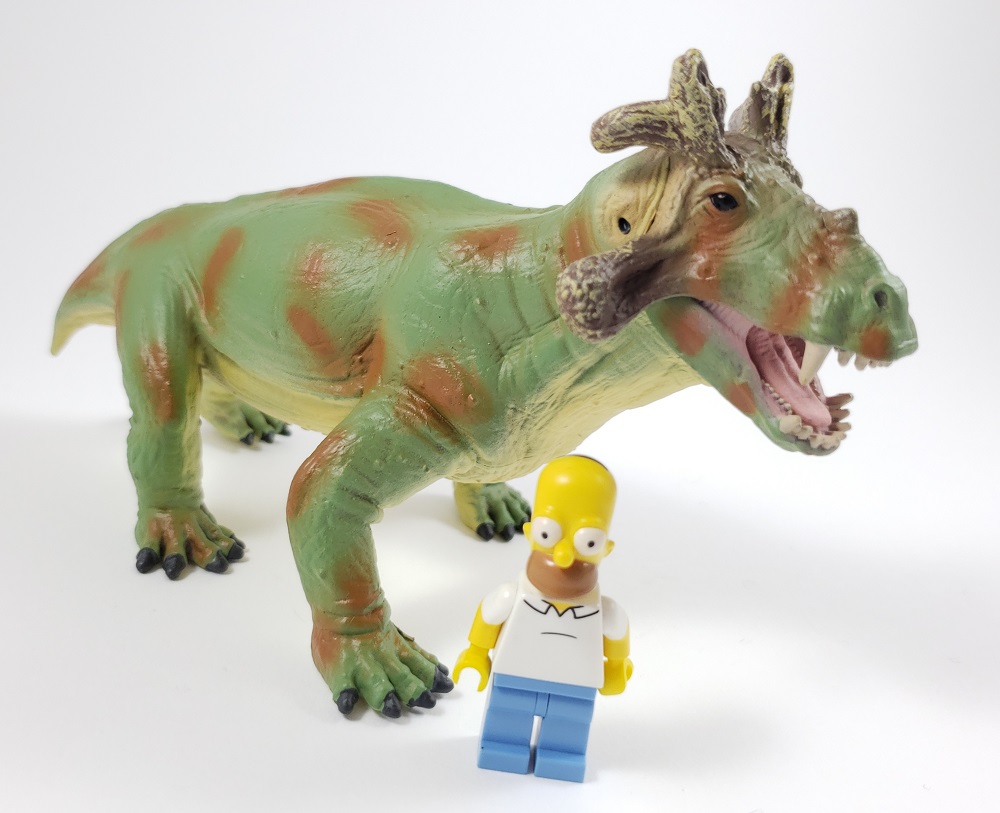
Disclaimer: links to Ebay and Amazon on the DinoToyBlog are affiliate links, so we make a small commission if you use them. Thanks for supporting us!




Collecta’s Estemmenosuchus figure represents E. mirabilis, which was the smaller of the 2 species of Estemmenosuchus . The other, E. uralensis was substantially larger (30% +) but had a less ornate head.
I like that Collecta made this figure, but it cries out for a more realistic paint job in my view.
Was looking forward to a review of this figure.
Great review!
Hopefully Collecta will make more. Would love to see a Permian tube someday with Edaphosaurus and the other neglected beasties.
That would indeed be swell!
Apart from being the best estemmenosuchus made in the toy market Estemmenosuchus of Collecta is one of the best figures made by this company this year and I go further is one of the best figures of prehistoric animals made in this year 2018.
Despite the criticism I unfairly understand against him, he does not have to envy this figure like so many others from Collecta to the best resin figures. On the other hand it is one of my favorite figures and unfortunately I will have to wait several months before getting that desired figure.
I am convinced that the figure in person is even better than the images of any camera and any video.
I applaud Collecta’s brave decision to make that luxury figure and at the same time very rare in the toy market.
Great review, Halichoeres.
I am happy to have bought the figure, though I have to admit I used it for customization…. added lips to cover the bare teeth in front, bulked up the muzzle and back of the head and cut off the better part of the antlers as I find E. uralensis more intersting than mirabilis. And sure the paint job got changed (as on most of my CollectAs).
As you mentioned it scales well to several Permina figures as the Safari Dimetrodon or Papo’s. Despite the probable gap of time between those, all those look rather unimpressive next to the Estemmenosuchus as the bulk of the figure dwarfs those predators.
Thanks! Interesting that you find uralensis more interesting; I suspect that most people prefer the more ornamented of the two. I neglected to mention the muzzle, but that is another area that could have been improved.
Now for some other impressive Permian beasts, like Keratocephalus, Cotylorhynchus, or Titanophoneus, to continue dwarfing our many Dimetrodon figures…
Terrific review. The colour scheme honestly doesn’t bother me, although I agree it could have been better. And I certainly agree that Paleozoic fauna are sorely in need of greater representation.
Thanks very much!